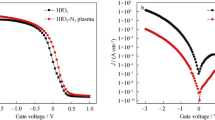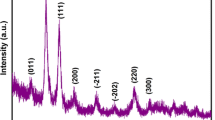Abstract
The effects of postdeposition annealing (PDA) on the interface between HfO2 high-k dielectric and bulk silicon were studied in detail. The key challenges of successfully adopting the high-k dielectric/Si gate stack into advanced complementary metal–oxide–semiconductor (CMOS) technology are mostly due to interfacial properties. We have proposed a PDA treatment at 600°C for several different durations (5 min to 25 min) in nitrogen or oxygen (95% N2 + 5% O2) ambient with a 5-nm-thick HfO2 film on a silicon substrate. We found that oxidation of the HfO2/Si interface, removal of the deep trap centers, and crystallization of the film take place during the postdeposition annealing (PDA). The optimal PDA conditions for low interface trap density were found to be dependent on the PDA duration. The formation of an amorphous interface layer (IL) at the HfO2/Si interface was observed. The growth was due to oxygen incorporated during thermal annealing that reacts with the Si substrate. The interface traps of the bonding features, defect states, and hysteresis under different PDA conditions were studied using x-ray photoelectron spectroscopy (XPS), x-ray diffraction (XRD), transmission electron microscopy (TEM), and leakage current density–voltage (J–V) and capacitance–voltage (C–V) techniques. The results showed that the HfO2/Si stack with PDA in oxygen showed better physical and electrical performance than with PDA in nitrogen. Therefore, PDA can improve the interface properties of HfO2/Si and the densification of HfO2 thin films.
Similar content being viewed by others
References
G.D. Wilk, R.M. Wallace, and J.M. Anthony, J. Appl. Phys. 89, 5243 (2001).
S.Y. Tan, Microelectron. J. 38, 783 (2007).
M.H. Cho, D.H. Ko, Y.G. Choi, K. Jeong, D.Y. Noh, H.J. Kim, and C.N. Whang, J. Vac. Sci. Technol. A 19, 192 (2001).
I. De, D. Johri, A. Srivastava, and C.M. Osburn, Solid-State Electron. 44, 1077 (2000).
R. Jiang, E.Q. Xie, and Z.F. Wang, Appl. Phys. Lett. 89, 2907 (2006).
D. Schmeiser and E. Zschech, Mater. Sci. Semicon. Proc. 9, 934 (2006).
S.J. Chang, W.C. Lee, J. Hwang, M. Hong, and J. Kwo, Thin Solid Films 516, 948 (2008).
S. Spiga, C. Wiemer, G. Tallarida, G. Scarel, S. Ferrari, G. Seguini, and M. Fanciulli, Appl. Phys. Lett. 87, 112904 (2005).
K. Maitra and V. Misra, IEEE Electron. Dev. Lett. 24, 707 (2003).
G. Pourtois, A. Lauwers, J. Kittl, L. Pantisano, B. Soree, S. De Gendt, W. Magnus, M. Heyns, and K. Maex, Microelectron. Eng. 80, 272 (2005).
S.Y. Tan, J. Electron. Mater. 38, 2314 (2009).
K.P. Bastosa, C. Driemeiera, R.P. Pezzia, G.V. Soaresa, L. Miottia, J. Moraisa, I.J.R. Baumvolb, and R.M. Wallace, Mater. Sci. Eng. B 112, 134 (2004).
A. Lauwers, M. de Potter, O. Chamirian, R. Lindsay, C. Demeurisse, C. Vrancken, and K. Maex, Microelectron. Eng. 64, 131 (2002).
M.-H. Cho, Y.S. Roh, C.N. Whang, K. Jeong, S.W. Nahm, D.-H. Ko, J.H. Lee, N.I. Lee, and K. Fujihara, Appl. Phys. Lett. 81, 472 (2002).
V. Mikhelashvili and G. Eisenstein, J. Appl. Phys. 89, 3256 (2001).
T. Tan, Z. Liu, H. Lu, W. Liu, and H. Tian, Opt. Mater. 32, 432 (2010).
Author information
Authors and Affiliations
Corresponding author
Rights and permissions
About this article
Cite this article
Tan, S.Y. Control of Interface Traps in HfO2 Gate Dielectric on Silicon. J. Electron. Mater. 39, 2435–2440 (2010). https://doi.org/10.1007/s11664-010-1323-0
Received:
Accepted:
Published:
Issue Date:
DOI: https://doi.org/10.1007/s11664-010-1323-0




